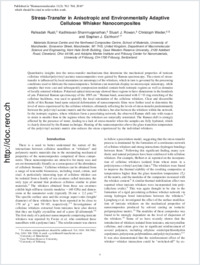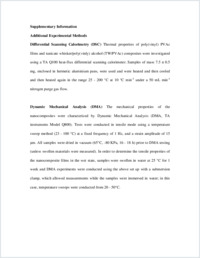Stress-transfer in anisotropic and environmentally adaptive cellulose whisker nanocomposites
- Rusli, Rafeadah Materials Science Centre and the Northwest Composites Centre, School of Materials, University of Manchester, UK
- Shanmuganathan, Kadhiravan Department of Macromolecular Science and Engineering, Kent Hale Smith Building, Case Western Reserve University, Cleveland, USA
- Rowan, Stuart J. Department of Macromolecular Science and Engineering, Kent Hale Smith Building, Case Western Reserve University, Cleveland, USA
- Weder, Christoph Department of Macromolecular Science and Engineering, Kent Hale Smith Building, Case Western Reserve University, Cleveland, USA - Adolphe Merkle Institute and Fribourg Center for Nanomaterials, University of Fribourg, Switzerland
- Eichhorn, Stephen J. Materials Science Centre and the Northwest Composites Centre, School of Materials, University of Manchester, UK
-
19.02.2010
Published in:
- Biomacromolecules. - 2010, vol. 11, no. 3, p. 762–768
English
Quantitative insights into the stress-transfer mechanisms that determine the mechanical properties of tunicate cellulose whisker/poly(vinyl acetate) nanocomposites were gained by Raman spectroscopy. The extent of stress-transfer is influenced by local orientation (or anisotropy) of the whiskers, which in turn is governed by the processing conditions used to fabricate the nanocomposites. Solution-cast materials display no microscopic anisotropy, while samples that were cast and subsequently compression molded contain both isotropic regions as well as domains of locally oriented whiskers. Polarized optical microscopy showed these regions to have dimensions in the hundreds of μm. Polarized Raman spectroscopy of the 1095 cm⁻¹ Raman band, associated with C−O ring stretching of the cellulose backbone, was used to quantify the local orientation of the cellulose whiskers. Clear and discernible shifts of this Raman band upon uniaxial deformation of nanocomposite films were further used to determine the level of stress experienced by the cellulose whiskers, ultimately reflecting the levels of stress-transfer predominantly between the poly(vinyl acetate) matrix and the tunicate whiskers, but also between the whiskers within the network. In the isotropic regions, where whiskers form a percolating network, the observed Raman shift rate with respect to strain is smaller than in the regions where the whiskers are uniaxially orientated. The Raman shift is strongly affected by the presence of water, leading to a lack of stress-transfer when the samples are fully hydrated, which is clearly detected by the Raman technique. Heating of the nanocomposites above the glass transition temperature of the poly(vinyl acetate) matrix also reduces the stress experienced by the individual whiskers.
- Faculty
- Faculté des sciences et de médecine
- Department
- AMI - Chimie des polymères et matériaux
- Language
-
- English
- Classification
- Chemistry
- License
-
License undefined
- Identifiers
-
- RERO DOC 18327
- DOI 10.1021/bm1001203
- Persistent URL
- https://folia.unifr.ch/unifr/documents/301584
Other files
Statistics
Document views: 110
File downloads:
- pdf: 338
- Supplementary material: 121

